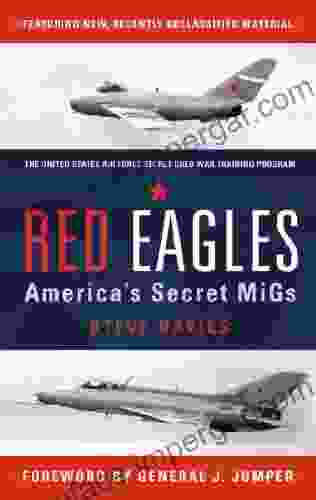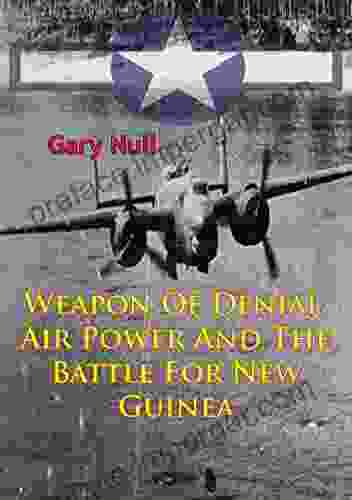Red Eagles: America's Secret MiGs

In the depths of the Cold War, as the United States and the Soviet Union engaged in a tense and perilous arms race, a daring and highly classified operation was underway. American engineers and pilots were secretly acquiring, flying, and testing captured Soviet MiG fighter jets, gaining unparalleled insights into the capabilities and tactics of their adversaries.
4.3 out of 5
| Language | : | English |
| File size | : | 12957 KB |
| Text-to-Speech | : | Enabled |
| Screen Reader | : | Supported |
| Enhanced typesetting | : | Enabled |
| X-Ray | : | Enabled |
| Word Wise | : | Enabled |
| Print length | : | 618 pages |
The program, known as "Project Red Eagles," was born out of necessity. In the early years of the Cold War, the United States lagged behind the Soviet Union in the development of advanced jet fighters. The MiG-15, a sleek and deadly machine, had proven its superiority in the Korean War, posing a serious threat to American pilots.
Determined to close the gap, the CIA and the US Air Force embarked on a audacious mission to obtain and study Soviet aircraft. Through clandestine operations and diplomatic channels, American agents managed to acquire several MiG-15s from Egypt and Poland. These jets were then secretly shipped to Groom Lake, Nevada, better known as Area 51, where they were subjected to rigorous testing and evaluation.
To fly these captured MiGs, the Air Force recruited a select group of highly skilled test pilots. These men, known as the "Red Eagles," were tasked with pushing the limits of the Soviet aircraft, assessing their performance, maneuverability, and combat capabilities.
The Red Eagles found that the MiG-15 was a formidable adversary. It was fast, agile, and heavily armed. However, it also had its limitations. The jet's range was relatively short, and its avionics were not as advanced as those of American aircraft. Nevertheless, the MiG-15 provided valuable lessons about Soviet design philosophy and tactics.
As the Cold War progressed, the Red Eagles program expanded to include testing of more advanced Soviet aircraft, such as the MiG-17 and MiG-21. These jets were even more capable than the MiG-15, and they posed an even greater threat to American airpower.
The Red Eagles' findings were invaluable to the US military. They helped to shape American fighter development and tactics, and they provided critical intelligence about Soviet aviation capabilities. The program also played a crucial role in training pilots to counter the threat of Soviet fighters in aerial combat.
Despite its importance, Project Red Eagles remained a closely guarded secret for decades. It was only in recent years that the full scope of the program and the incredible exploits of the Red Eagles have been declassified.
Today, the story of the Red Eagles stands as a testament to the ingenuity, skill, and bravery of American pilots and engineers. It is a tale of daring and deception, of technological espionage and military superiority. And it is a reminder that even in the darkest days of the Cold War, the pursuit of knowledge and the defense of freedom prevailed.
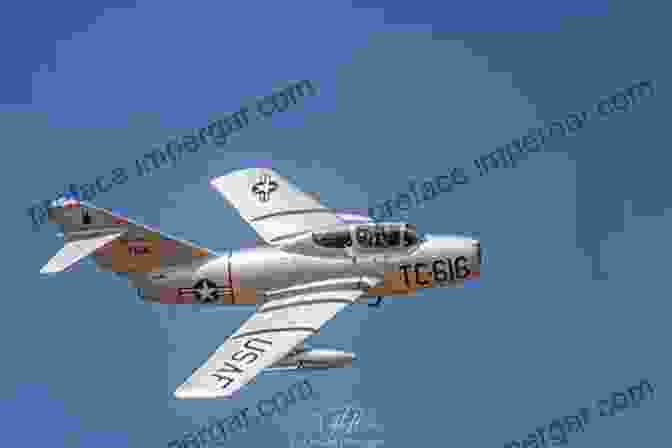
The Red Eagles Pilots
The Red Eagles pilots were a unique and elite group of men. They were selected for their exceptional flying skills, their technical expertise, and their unwavering dedication to their mission.
Among the most famous Red Eagle pilots was Major Robert L. "Bob" Lee. Lee was a Korean War veteran who had shot down two MiG-15s in combat. After the war, he was recruited to join the Red Eagles program, where he flew and tested numerous captured Soviet aircraft.
Another notable Red Eagle pilot was Captain John R. Boyd. Boyd was a brilliant strategist and innovator who later developed the "Energy-Maneuverability Theory," which revolutionized fighter combat tactics. Boyd's insights gained from flying MiG-15s were instrumental in the development of this theory.
The Red Eagles pilots faced numerous challenges and risks in their work. They flew aircraft that were unfamiliar and potentially dangerous. They often operated in secret, with little support or backup. And they knew that if they were captured, they could face severe consequences.
Despite the risks, the Red Eagles pilots remained committed to their mission. They were driven by a desire to protect their country and to advance the cause of freedom. Their bravery and dedication made them unsung heroes of the Cold War.
The Legacy of Red Eagles
Project Red Eagles played a significant role in the outcome of the Cold War. The program provided the United States with critical intelligence about Soviet aviation capabilities, and it helped to shape American fighter development and tactics.
The legacy of Red Eagles extends beyond the Cold War era. The program's findings continue to inform modern fighter design and combat tactics. And the story of the Red Eagles pilots serves as an inspiration to all who strive to defend freedom and to push the boundaries of human knowledge.
Today, the Red Eagles program is a reminder of the importance of technological espionage and military superiority in the defense of freedom. It is also a testament to the bravery and dedication of the pilots who risked their lives to fly captured Soviet aircraft.
The story of Red Eagles is a story that deserves to be told and retold. It is a story of courage, innovation, and the pursuit of freedom. It is a story that should inspire generations to come.
4.3 out of 5
| Language | : | English |
| File size | : | 12957 KB |
| Text-to-Speech | : | Enabled |
| Screen Reader | : | Supported |
| Enhanced typesetting | : | Enabled |
| X-Ray | : | Enabled |
| Word Wise | : | Enabled |
| Print length | : | 618 pages |
Do you want to contribute by writing guest posts on this blog?
Please contact us and send us a resume of previous articles that you have written.
 Book
Book Novel
Novel Page
Page Chapter
Chapter Text
Text Story
Story Genre
Genre Reader
Reader Library
Library Paperback
Paperback E-book
E-book Magazine
Magazine Newspaper
Newspaper Paragraph
Paragraph Sentence
Sentence Bookmark
Bookmark Shelf
Shelf Glossary
Glossary Bibliography
Bibliography Foreword
Foreword Preface
Preface Synopsis
Synopsis Annotation
Annotation Footnote
Footnote Manuscript
Manuscript Scroll
Scroll Codex
Codex Tome
Tome Bestseller
Bestseller Classics
Classics Library card
Library card Narrative
Narrative Biography
Biography Autobiography
Autobiography Memoir
Memoir Reference
Reference Encyclopedia
Encyclopedia Tim Crane
Tim Crane Mark Rubinstein
Mark Rubinstein Edward Cotton
Edward Cotton Doreen C Mampani
Doreen C Mampani Donald Bain
Donald Bain S K Gupta
S K Gupta Piers D Britton
Piers D Britton Tristram D Wyatt
Tristram D Wyatt Richard Gilman Opalsky
Richard Gilman Opalsky Donia Youssef
Donia Youssef Eduardo Lobianco
Eduardo Lobianco Lindsay C Gibson
Lindsay C Gibson Pablo Goldschmidt
Pablo Goldschmidt Donna Hardin
Donna Hardin Randy Bentinck
Randy Bentinck Doris Schroeder
Doris Schroeder Donald L Fisher
Donald L Fisher Geraldine Woods
Geraldine Woods Paul Harvey
Paul Harvey Kathryn Casey
Kathryn Casey
Light bulbAdvertise smarter! Our strategic ad space ensures maximum exposure. Reserve your spot today!
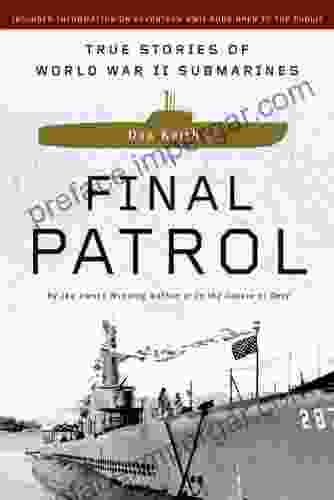
 Aaron BrooksTrue Stories of World War II Submarines: Uncover the Hidden Depths of Courage...
Aaron BrooksTrue Stories of World War II Submarines: Uncover the Hidden Depths of Courage... Felix CarterFollow ·15.1k
Felix CarterFollow ·15.1k Felipe BlairFollow ·17.8k
Felipe BlairFollow ·17.8k Raymond ParkerFollow ·16.4k
Raymond ParkerFollow ·16.4k George R.R. MartinFollow ·7.5k
George R.R. MartinFollow ·7.5k Braden WardFollow ·4.5k
Braden WardFollow ·4.5k Al FosterFollow ·14.3k
Al FosterFollow ·14.3k Gregory WoodsFollow ·9.7k
Gregory WoodsFollow ·9.7k Griffin MitchellFollow ·7.3k
Griffin MitchellFollow ·7.3k

 Donovan Carter
Donovan CarterUnveiling the Tapestry of Western Civilization:...
: Step into the annals of Western...

 Pablo Neruda
Pablo NerudaUnveil the Secrets: The Welsh Murder Mysteries
Prepare to be captivated as...

 Benji Powell
Benji PowellNot Without Our Consent: Lakota Resistance to...
In the mid-20th...
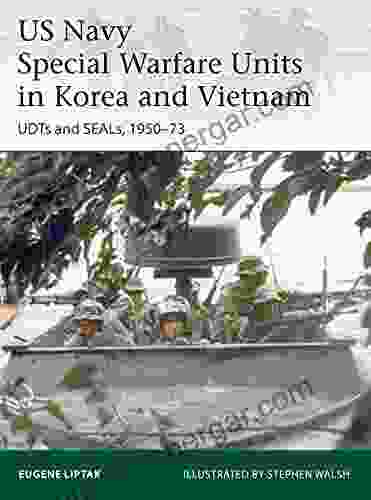
 Ryan Foster
Ryan FosterUncover the Heroic Exploits of U.S. Navy Special Warfare...
The annals of modern warfare are replete...

 Gage Hayes
Gage HayesPlan to Provide Quality Care for All While Saving...
The healthcare...

 Felix Carter
Felix CarterUnveiling the Timeless Wisdom of Machiavelli: The...
Niccolò...
4.3 out of 5
| Language | : | English |
| File size | : | 12957 KB |
| Text-to-Speech | : | Enabled |
| Screen Reader | : | Supported |
| Enhanced typesetting | : | Enabled |
| X-Ray | : | Enabled |
| Word Wise | : | Enabled |
| Print length | : | 618 pages |


